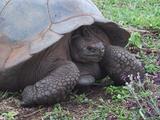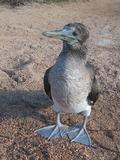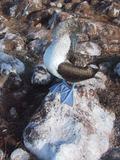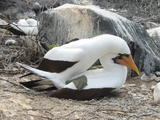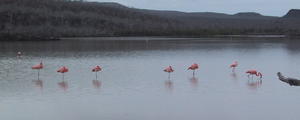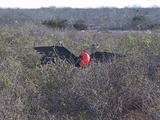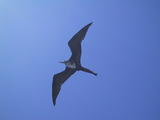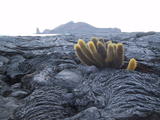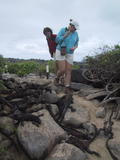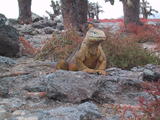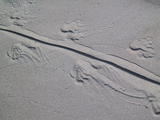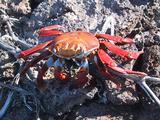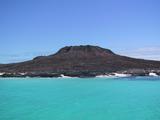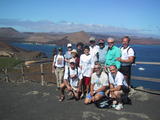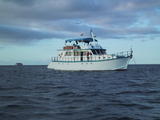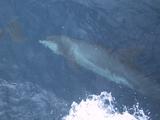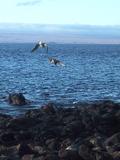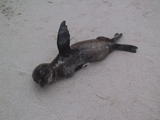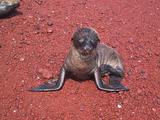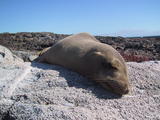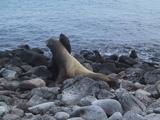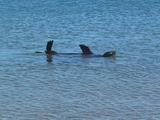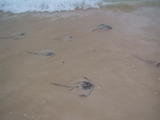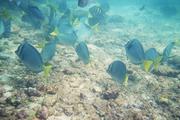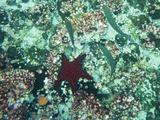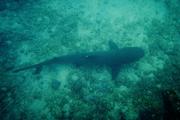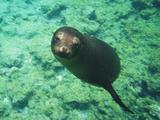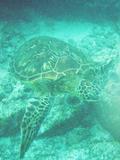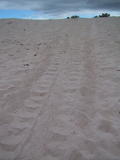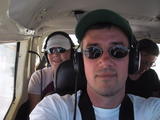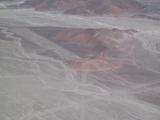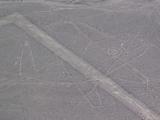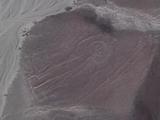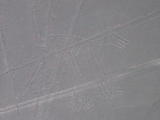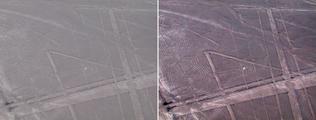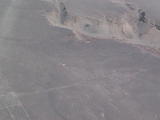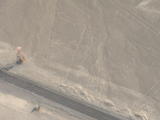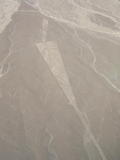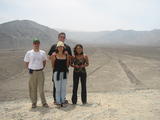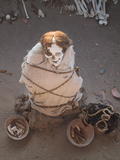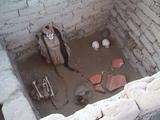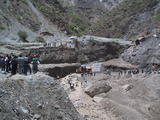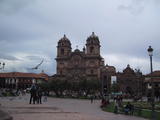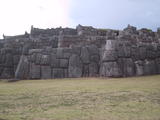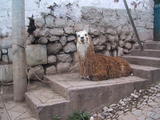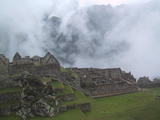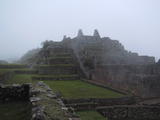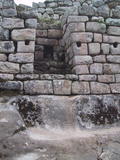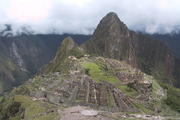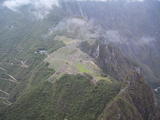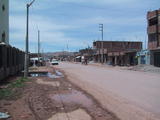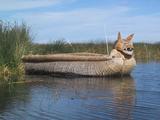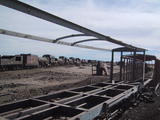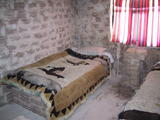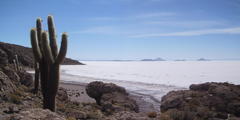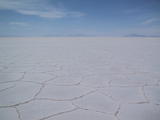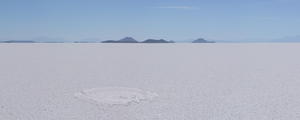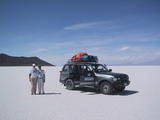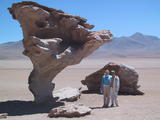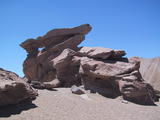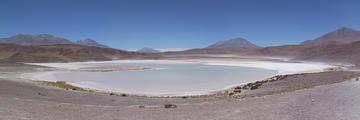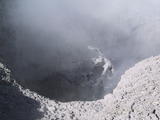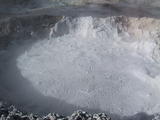| < < < Previous story | Next story > > > | |
Galapagos, Nazca Lines, Machu Picchu and the Uyuni DesertUshuaia/Puerto Natales, 11 January 2004
Contents:GalapagosWe left Europe on November 11th, 2004, too late to miss the start of colder autumn days, but well in time to miss the start of winter, unlike the previous year when we left Europe in the beginning of January! With 19.5kg of check-in luggage and 2.5kg of carry-on luggage, between the two of us, we flew from Amsterdam to Quito, via Madrid with Iberia. Full of expectations we arrived in Quito, where we met Erik and Chisako, who had arrived a day earlier. Our first task was to organize a trip to the Galapagos, after some searching we found an agency that had a last minute offer for a boat called the Yolita and reservations for the flights to and from the islands. The boat had 6 small cabins for two persons each, each cabin had a private little bathroom. With only 12 passengers on the boat the group would not be too big. We had a guide and a cook, Jorge and José, both of whom did a great job. For example whenever we returned from a trip there would be little snacks waiting for us. It felt like coming home to your mother. The pelicans loved José as well, while he was cooking, they were always floating near the boat waiting for leftovers. Before heading out to sea, we were taken inland to see the giant Galapagos tortoises, which from a distance look like giant rocks, that sometimes move! These are land turtles and each island has a native species that is distinct from the others. On one island the native turtles are extinct except for one individual, kept in the Darwin Research Center, a male who in spite of being presented several females from an other species, still refuses to mate. He is nicknamed: Lonesome George. A subject Jorge elaborated on several times, perhaps out of pity for the animal. For example he shared details, of how a young woman, I believe from Switzerland, spent a year trying to make the tortoise ejaculate. We got to visit Lonesome George and the Darwin Research Center at the end of our stay in the Galapagos. As a last hope, cloning Lonesome George may be an option, since it is the incubation temperature of the eggs that determine a tortoise's gender, both a male and a female could be cloned from him. There are projects to regenerate depleted turtle populations on other islands by breeding them in the Research station and releasing them. Since the survival rate of turtles in the wild is so low, but they lay so many eggs to overcome the odds, it is relatively easy to breed them in large numbers. The small turtles are cute to look at, it is difficult to imagine that they will become so big! On Santa Cruz we also walked through a lava tunnel. This is a tunnel created by streaming lava, as the lava on the surface cools off and solidifies, the lava inside the stream continues to flow, so when the last lava has passed all that remains is an empty tunnel. Later when a part of the roof collapses an entry to the tunnel is created. We left Puerto Ayora for Rabida, navigating through the night. Besides Rabida we also visited Sombrero Chino and San Bartolomé the next day. All three are small islands close to the island of Santiago. Here were our first encounters with sea lions lying side by side across the beach. Every male has his own harem of 10 to 40 females and his own stretch of beach, from which he chases other males. These males are nicknamed: beach masters, the other males are referred to as bachelors. We did a lot of snorkeling, unfortunately the water was a bit cold, but once in and moving we got used to it. Sea lions, swam around us, playing with us. They swam towards us a high speed only to change direction at the last moment! Trying to touch them was useless, as they passed so quickly that you hardly had time to react! Fortunately these were female sea lions, the males are much more aggressive, but are mostly on the beach defending their territory. Some people though have actually been bitten by male sea lions before, Jorge had even seen it happen. While snorkeling we also saw several white tipped sharks and sea turtles, while dolphins sometimes accompanied the boat when we went from one island to the other. On land, we saw the famous blue footed boobies, a bird that has no natural predator. Watch out where you walk, as they don't even bother to move out of the way! Similarly iguanas of up to 50cm are lying on the footpaths with no intention to budge. This is what the Galapagos islands are so famous for! You can just walk up to these animals and take a close up picture. In the mean time frigate birds inflated their red throat pouches trying to court females. We got to walk on "recent" lava fields, maybe 100 years old, still mostly devoid of vegetation. One can observe a few plants starting to grow here and there. The lava was pretty light, so that it is possible to lift a big looking rock over your head, without too much effort. There are several types of lava, in particular one on which you can easily walk, called "pahoehoe", and one on which you can't without hurting your feet called "aa". Returning from an excursion we saw mating sea turtles, whereby the male climbs on top of a female, that is desperately trying to stay afloat. In a mangrove bay north of Santa Cruz, we observed sharks swimming between the mangroves and rays gliding below our dingy. After 3 days we had to drop off the 8 American co-passengers on Baltra island, where the airport is located, and pick up 8 new guests. This left us stranded for a couple of hours in a little bay. We spent some of this time on the beach, where we watched a dog chase away a sea lion that tried to get on the beach. This made it vividly clear how imported species are slowly destroying the native wildlife. Actually I am surprised that cats and dogs are even allowed on any of these islands! Later that day we navigated to Isla Plaza Sur, just west of Santa Cruz, where we dropped anchor for the night. At night we could hear the sea lions! The next day we witnessed a real fight between two male sea lions. The intruder was defeated but both sea lions got wounded! From Isla Plaza Sur we navigated through the night to the island of Española, where we observed an albatross mating ritual, a very lengthy affair! A little later other albatrosses were taking off and landing. An albatross must first start to run in order to gain speed, because unlike smaller birds it can not take off on the spot. To make it easier they often prefer to walk to a cliff to jump off! The same island hosts a blow hole, a place where waves go through an opening in the rocks and blow sea water high into the air. After some more snorkeling we went on to Floreana where we saw many flamingos feeding in a lake. Flamingos made it to the Galapagos independently but not that long ago, so they are a relatively new species on these islands. On the last island of our trip, was a cave with an underground lake. We ventured into the cave while the crew played a game of soccer against the crew of an other boat. The Galapagos islands are amazing and well worth the trip. It is an expensive destination, we spent as much in a week as we normally would spend during 1 month of traveling! But you really get to see some extraordinary animals, different on every island. Most of them are not scared of human beings, since they are not used to having natural predators. NazcaAfter a week at sea, we needed a little rest, so after arriving in Guayaquil, we took the bus to Northern Peru for another 6 hours. Not exactly a rest you would think, but after getting there we crashed in a small sea side hotel in a small town called Zorritos, near Tumbes, where we spent several days recovering. It is quite funny how long you keep the impression that things are moving as if you were still on the boat! From Tumbes we flew to Lima and continued the same day by bus and colectivo to Nazca, near the world famous Nazca Lines. In the vivid imagination of Erich von Daniken these lines had been landing strips for extra-terrestrials. Having now seen the lines this theory seems rather unlikely, especially given the fact that they can easily be made by human beings without any complicated techniques. Amongst these lines are mysterious figures or drawings of such things as a hummingbird, a spider, a condor, a monkey and amongst others things one wishfully interpreted as an astronaut. A curious aspect of these lines and figures and the probable causes all the extra-terrestrial theories, is that they can only be observed from the air! During a half hour flight over these lines, you get to see nearly all of these figures. The small 5 passenger plane flies over these figures turning from side to side so that the passengers on both sides can observe. A half hour of this nearly makes you throw up so the staff has attentively placed small bags in front of you for this eventuality. We managed to keep the contents of our stomachs inside, but barely! Two of the figures and several lines have unfortunately been (partially) destroyed by the Interamericana. The road having been built before anybody realized that these lines and drawings were there, that is before anybody had flown over it. It is funny to think, that the pre-Inca civilization that made these lines was probably trying to make drawings for the gods, but it is tourists like us that get to see it, more than a thousand years later! Near Nazca are also some burial grounds, with mummified bodies, in the pre-Inca Cemeterio de Chauchilla. At least those which have not been destroyed by looters (yet) can still be seen. Machu PicchuThe overnight bus from Nazca to Cuzco, turned out to be quite eventful, as two sections of the road had been washed away. The first was small enough for a bulldozer to create a single lane path through the mud, but the second washout had literally taken away 20 meters of road leaving a gaping hole 7 meters deep! After waiting in vain for 3 hours, we crossed on foot carrying our backpacks, down 7 meters, across the streaming water and back up a 7 meter mud wall, to a bus on the other side, the occupants of which in turn moved themselves and their belongings to our original bus. 24 hours after leaving Nazca we arrived in Cuzco. Which has a colonial atmosphere, a beautiful center and a temperate climate that was refreshing after the weeks of heat. The lack of oxygen in the air, due to the elevation, makes any physical exercise exhausting, even just climbing the stairs in the hostel. Eventually though you get used to it a bit. The thing to see near Cuzco is of course Machu Picchu. The Peruvians know this and exploit it to the max. So since there is no road to Machu Picchu, but only a train line, the monopolistic state run railroad company Peru Rail, simply prohibits foreigners from boarding the local train (a return ticket on which costs less than 8.5 USD) and instead forces foreigners to use one of their "special" trains, the cheapest of which is supposedly for backpackers and cost a whopping 55 USD! Furthermore there is only 1 of these so-called "backpacker" trains per day at the uncomfortable time of 6 am. It takes 3 hours to get to your destination at an immensely slow speed, while the leg room, even for a small person like me, is too little, as your legs just fit between the legs of the person sitting opposite you and facing you. The rip off does not end there as foreigners still need to take a 9 USD bus from the station to the ruins for some 20 minutes, twice as much as an 10 hour bus ride anywhere else in the country! Now this train ride is supposed to be quite special, and it is, it crawls up the mountain side, by going back and forth, at the end of each stretch reversing direction to take the next stretch up. The scenery slides by as you crawl through a spectacular valley. Machu Picchu itself, was unfortunately filled up with visitors, maybe because it was a Sunday, so all the Peruvians who pay only a fraction of what we paid to get there, were out in force. As some of them were walking around with blaring radios the serenity of the place was somewhat spoilt!!! But the location is magnificent, it is hard to imagine what got them to build in this spot! We climbed up the mountain Huayna Picchu, the high peak located behind Machu Picchu. Steep and requiring serious effort, but rewarding you with a great view over Machu Picchu far away from the crowds below. If you arrive in the town of Aguas Calientes, at the end of the train line, as we did, the day before you make your way to Machu Picchu, it enables you to get there before the crowds from Cuzco arrive by train. We spent some time the first day in the supposedly hot springs, a mayor disappointment, as it was mess of tasteless concrete small pools, with at best lukewarm water. We spent a few days more in Cuzco before heading out to Juliaca, a town as ugly as any town can get, with barely any unfinished building or paved road. What were we doing here you may ask? Well just visiting a friend of a friend, Luis, who is a priest there. A most sympathetic man. Our next stop was Puno, from there we did a day trip to the floating Islands of the Uros. A tribe that fled from the Incas to live on the lake. Nowadays you may be forgiven to suspect that the practice is maintained solely for tourism. BoliviaWe moved on to La Paz in Bolivia, where we were fortunate to find a little apartment on the top floor of an hotel with several rooms for the four of us. We stayed there 3 nights. Because Bolivia just suffered mayor civil unrest, in which 60 people died and the president had to step down, I read up on the news. The situation was now quiet, we did not feel unsafe and people were very friendly to us. Instead Hugo Chavez had been visiting and used the opportunity to stir up old rivalries between Bolivia and Chile, by stating that he would one day like to swim on a Bolivian beach. Apparently more than 100 years ago, during the war of the Pacific, Bolivia lost its coastal areas to Chile and thus access to the sea. Chile has offered to build railroads from two Chilean ports to Bolivia and permit the transit of goods unhindered by Chilean duties, but this has been refused by Bolivia. It seems silly to think that Chile might give up territory without fighting and losing a war against Bolivia, as well as extremely unlikely that Bolivia might win such a war. Rather than serving as a mediator for a practical and peaceful solution, Chavez must have thought that this was a great opportunity to divide South Americans and take away the attention from the way Chavez is practically banning the opposition at home. In the mean time one out of every 5 Venezuelans is out of a job and Colombia accuses his government of financing FARC terrorism! Before coming to Central and South America I never realized how many conflicts there are here. The above mentioned is just one of them, some other conflicts we heard about: Honduras and El Salvador had a war in 1969 known as the Football War! Ecuador and Peru had a border war in 1941 and again in 1995. UyuniSo much for South American politics. Next we headed for the desert town of Uyuni, from where we crossed the Uyuni salt flat and the Andes during a 3 day overland tour in a 4WD. This was undoubtedly one of the most impressive parts of our trip. An indescribable scenery, tall colorful mountains all around, while driving through salt flats and valleys themselves already at 3000 to 4500 meters. Unforgettable was driving over the worlds largest salt flat, the Salar de Uyuni, a seemingly endless white colored, flat extent, a left over on the sea bed of a dried up sea, with here and there some rocky "islands" with vegetation, mostly cacti. Higher up in the mountains are colorful lakes, some of which play host to large numbers of flamingos. There are also a few geysers and bubbling mud pools. Before leaving Uyuni we tasted the local beverage, coca-tea. This supposedly helps against the effects of high altitude, but it is quite tasteful as well. The tour by 4WD dropped us off in the Chilean town of San Pedro de Atacama. From where I will continue in the next travel update. If you would like to be notified when we write more about our trip, just send us an E-mail. e-mail Otto de Voogd p.s. Erik has also written about our travels in Ecuador, Peru and Bolivia. PhotosGalapagosNazcaCuzcoMachu PicchuLake TiticacaUyuni DesertPractical Information
To my knowledge the information provided here was accurate
at the time of our visit. However time passes and things can change.
Money(ATMs for Maestro/Cirrus bankcards)
Ecuador: ATMs of Banco del Pacifico and Banco Guayaquil.
CostsNote that exchange rates can be very volatile, for example the Euro rose 10 percent against the US Dollar during this part of the trip alone. Ecuador - The US Dollar is the national currency
Quito - L'Auberge Inn:
16 USD per double room, private bathroom with warm water.
Peru - Sols (PEN) approx. rates: 1 USD = 3.5 PEN, 1 EUR = 4.20 PEN
Zorritos - Hotel Costa Azul: 15 USD per person
incl. 3 meals, private bathroom, cold water.
Bolivia - Bolivianos (BOB) approx. rates: 1 USD = 7.80 BOB, 1 EUR = 9.40 BOB
La Paz - Hotel Continental:
50 BOB per person for apartment 401
(for 4 people this was a great deal)
| ||
| < < < Previous story | Next story > > > | |
New | About | Contact | Connect | Friends | Promotions | Copyright | Advertise

